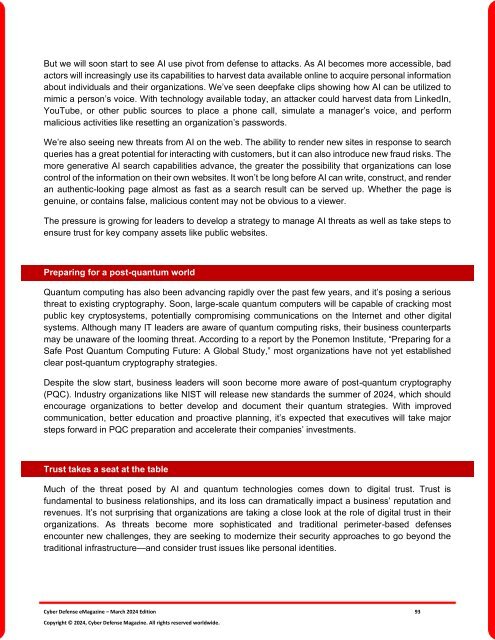The Cyber Defense eMagazine March Edition for 2024
Cyber Defense eMagazine March Edition for 2024 #CDM #CYBERDEFENSEMAG @CyberDefenseMag by @Miliefsky a world-renowned cyber security expert and the Publisher of Cyber Defense Magazine as part of the Cyber Defense Media Group as well as Yan Ross, Editor-in-Chief and many more writers, partners and supporters who make this an awesome publication! 225 page March Edition fully packed with some of our best content. Thank you all and to our readers! OSINT ROCKS! #CDM #CDMG #OSINT #CYBERSECURITY #INFOSEC #BEST #PRACTICES #TIPS #TECHNIQUES
Cyber Defense eMagazine March Edition for 2024 #CDM #CYBERDEFENSEMAG @CyberDefenseMag by @Miliefsky a world-renowned cyber security expert and the Publisher of Cyber Defense Magazine as part of the Cyber Defense Media Group as well as Yan Ross, Editor-in-Chief and many more writers, partners and supporters who make this an awesome publication! 225 page March Edition fully packed with some of our best content. Thank you all and to our readers! OSINT ROCKS! #CDM #CDMG #OSINT #CYBERSECURITY #INFOSEC #BEST #PRACTICES #TIPS #TECHNIQUES
Create successful ePaper yourself
Turn your PDF publications into a flip-book with our unique Google optimized e-Paper software.
But we will soon start to see AI use pivot from defense to attacks. As AI becomes more accessible, bad<br />
actors will increasingly use its capabilities to harvest data available online to acquire personal in<strong>for</strong>mation<br />
about individuals and their organizations. We’ve seen deepfake clips showing how AI can be utilized to<br />
mimic a person’s voice. With technology available today, an attacker could harvest data from LinkedIn,<br />
YouTube, or other public sources to place a phone call, simulate a manager’s voice, and per<strong>for</strong>m<br />
malicious activities like resetting an organization’s passwords.<br />
We’re also seeing new threats from AI on the web. <strong>The</strong> ability to render new sites in response to search<br />
queries has a great potential <strong>for</strong> interacting with customers, but it can also introduce new fraud risks. <strong>The</strong><br />
more generative AI search capabilities advance, the greater the possibility that organizations can lose<br />
control of the in<strong>for</strong>mation on their own websites. It won’t be long be<strong>for</strong>e AI can write, construct, and render<br />
an authentic-looking page almost as fast as a search result can be served up. Whether the page is<br />
genuine, or contains false, malicious content may not be obvious to a viewer.<br />
<strong>The</strong> pressure is growing <strong>for</strong> leaders to develop a strategy to manage AI threats as well as take steps to<br />
ensure trust <strong>for</strong> key company assets like public websites.<br />
Preparing <strong>for</strong> a post-quantum world<br />
Quantum computing has also been advancing rapidly over the past few years, and it’s posing a serious<br />
threat to existing cryptography. Soon, large-scale quantum computers will be capable of cracking most<br />
public key cryptosystems, potentially compromising communications on the Internet and other digital<br />
systems. Although many IT leaders are aware of quantum computing risks, their business counterparts<br />
may be unaware of the looming threat. According to a report by the Ponemon Institute, “Preparing <strong>for</strong> a<br />
Safe Post Quantum Computing Future: A Global Study,” most organizations have not yet established<br />
clear post-quantum cryptography strategies.<br />
Despite the slow start, business leaders will soon become more aware of post-quantum cryptography<br />
(PQC). Industry organizations like NIST will release new standards the summer of <strong>2024</strong>, which should<br />
encourage organizations to better develop and document their quantum strategies. With improved<br />
communication, better education and proactive planning, it’s expected that executives will take major<br />
steps <strong>for</strong>ward in PQC preparation and accelerate their companies’ investments.<br />
Trust takes a seat at the table<br />
Much of the threat posed by AI and quantum technologies comes down to digital trust. Trust is<br />
fundamental to business relationships, and its loss can dramatically impact a business’ reputation and<br />
revenues. It’s not surprising that organizations are taking a close look at the role of digital trust in their<br />
organizations. As threats become more sophisticated and traditional perimeter-based defenses<br />
encounter new challenges, they are seeking to modernize their security approaches to go beyond the<br />
traditional infrastructure—and consider trust issues like personal identities.<br />
<strong>Cyber</strong> <strong>Defense</strong> <strong>eMagazine</strong> – <strong>March</strong> <strong>2024</strong> <strong>Edition</strong> 93<br />
Copyright © <strong>2024</strong>, <strong>Cyber</strong> <strong>Defense</strong> Magazine. All rights reserved worldwide.

















